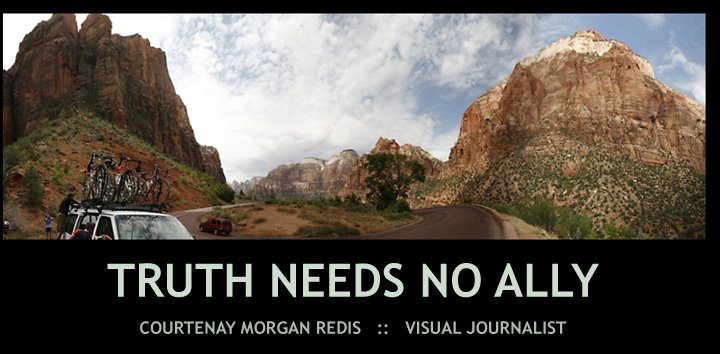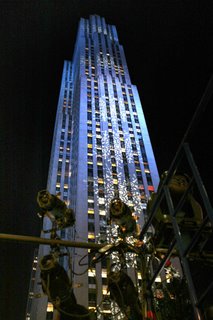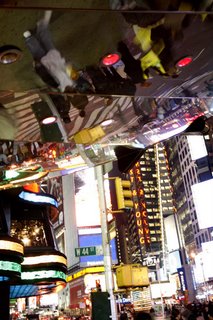 MARATHON: Marathoners Go the Distance From Ethiopia to New York
MARATHON: Marathoners Go the Distance From Ethiopia to New YorkBy JULIET MACUR
[Photographs by Courtenay Redis, not originally part of NY Times story]October 26, 2005
On one lazy afternoon in mid-October, two of New York City's top marathoners awoke from naps inside their Bronx apartment and tiptoed around the out-of-town visitor asleep on the living room floor.

Amharic church music from Ethiopia, their home country, played loudly from a bedroom stereo. The menthol scent of Icy Hot hung heavy in the air. But the visitor, crashed out in running pants and a T-shirt, with a half-empty bottle of Gatorade next to his head, did not flinch.
''That guy finished sixth in the 2000 Olympics in the 1,500 meters,'' Kassahun Kabiso said nonchalantly as he pointed to Daniel Zegeye, the man snoozing atop two thin quilts. ''He's just one of our friends from Ethiopia.''
 Kabiso and his roommate, Retta Feyissa
Kabiso and his roommate, Retta Feyissa, train twice a day for the New York City Marathon, and Feyissa works a full-time job as a housekeeper at a Manhattan nursing home.
But they always make time to serve as hosts for other Ethiopian runners like Zegeye in their two-bedroom apartment in the Kingsbridge section of the Bronx. They try to help their countrymen because they know how difficult it is to be a professional runner here.

Several years ago, Kabiso and Feyissa left their large families and meager farms in Ethiopia and came to the United States to run races and win prize money. They did not speak English or have much cash, but they wanted to live in a country that offered more opportunity than their own.
Kabiso, who has 16 brothers and sisters, is from Awassa, a lakeshore town about 130 miles south of Addis Ababa. He left Ethiopia in 2002, and, now 23, he is here on a renewable temporary visa. Feyissa, who is 30 and has 10 siblings, is from Sululta, an agricultural village about 12 miles north of Addis Ababa. He left in 2000, seeking political asylum here because he feared being sent to fight in the border war against Eritrea, during which an estimated 100,000 people were killed.
The two eventually ended up at the Mecca for African runners in New York: the
Westchester Track Club.
''The Africans come, they arrive, they fall from the sky,'' said Mike Barnow, 62, who founded the club in 1976 and has coached there since. ''Who knows how these runners get here, but they get here.''
Once, four Moroccan runners ditched their flight home from the world cross-country championships in Boston and sought out Barnow the next day. Other times, African runners have seemingly arrived out of nowhere at Barnow's practices at Irvington (N.Y.) High School after other runners recommended him.
Barnow, a thin man with bushy gray eyebrows and an S.U.V. filled with stopwatches, measuring tapes and notebooks, began coaching Africans in 1982, when he was a coach at Pace University. He met Jama Aden, a Somali student at Fairleigh Dickinson, at an invitational track meet, and they made a connection. Aden wanted Barnow to coach him, and Barnow agreed.

Then the pipeline from East Africa to Westchester began to flow. At the 1984 Summer Olympics, Barnow coached the Somali track team and a Kenyan runner, Sosthenes Bitok, who finished sixth in the 10,000 meters.
''I had to beg Sosthenes to run in the Kenyan Olympic trials because for him, like a lot of these Africans, it was all about money,'' said Barnow, who is divorced and has no children. ''You really can't blame them because there's nothing, absolutely nothing, for them back home.''
Barnow has coached runners from all over Africa, but in recent years, Ethiopians have become his top-level runners, particularly in the marathon. At the New York City Marathon last year, Kabiso and Feyissa helped the Westchester Track Club win the men's team championship. The two are in the sub-elite category, a notch below the best.
Two other top African runners will represent the Westchester Track Club in the New York City Marathon on Nov. 6: Abraham Assefa, an Ethiopian who finished fifth in the race in 2000, and Elarbi Khatabi, a former Olympian for Morocco.
Kabiso was 19th in New York last year with a time of 2 hours 22 minutes 21 seconds. In May, he achieved a personal best when he won the Vancouver Marathon in 2:15:40.
Feyissa finished the New York City Marathon last year in 29th place, in 2:27:29, a week after winning the Marine Corps Marathon in Washington, one of seven marathons he ran last year.

Feyissa did not win a penny for running in either race, but Kabiso won $5,000 for being the first local runner across the line in the New York City Marathon, which he has done three years in a row.
Leteyesus Berhe of Ethiopia, a Westchester Track Club teammate, won $5,000 for being the fastest female New Yorker in the race for the second straight year.
Barnow knows, perhaps more than anyone, what that money means to them.
Kabiso has no work visa, so his income is limited to what he can win in road races. He made about $10,000 in 20 races last year, he said. Berhe, who lives in a rooming house in the Bronx, worked bagging groceries before recently getting a job at the Nike store in Manhattan, where she takes people on runs in Central Park.
Feyissa has the steadiest income of them all.

Aside from winning about $15,000 in his 25 races last year, he works full time mopping floors and scrubbing bathrooms at a nursing home. He said it was a better job than he would have in Ethiopia, where he would be forced to join the army. He said professional runners and soldiers like Zegeye, the runner asleep on his apartment floor, made only $50 a month.
''In Ethiopia, they don't care about you as a professional athlete or your family,'' Feyissa said. ''They don't care if you die.''
At the Westchester Track Club, the Ethiopian runners do not have sponsors, though Barnow gets free shoes and clothes for them from Brooks, a sneaker and athletic apparel company. They also do not have agents, at least official ones. Without pay, Barnow helps them get into races across the country, negotiating travel and hotels and food stipends.
He also doubles as a real estate agent, accountant and general benefactor for a handful of the 12 Ethiopian runners in his club, which has more than 400 members.
Three months ago, he helped Feyissa and Kabiso get their new apartment, paying the $750 security deposit and the first month's rent so they would have a comfortable, safe place to live. The ceiling of Kabiso's old apartment leaked whenever it rained.
Barnow also opened a bank account for Kabiso, into which he deposits all of Kabiso's race winnings.

''We don't have any relatives or contacts here, so Mike, he has been like our father,'' Kabiso said.
Feyissa and Kabiso, who have not seen their families in years, made friends at the Amharic services at Emmanuel Worship Center in the Bronx. Feyissa and his wife, Abeba Tola, divorced while he was away. He has two children, who are 9 and 11. He said they cried and asked him to return to Ethiopia whenever he talked to them on the phone.
A few weeks ago, though, Tola, 29, came to New York to run races over several months and is staying with Feyissa. The day before her first race, the Hartford Marathon, Barnow rushed to get running shoes for her because she had none. She won that race, then won the Mystic Places Marathon in East Lyme, Conn., two weeks later. Quickly, she became just another African runner looking for a ride home from Barnow's practices. (None of them have cars.)
Barnow bristles at the kind of racing schedule Tola has had since she arrived because he does not want his runners overtraining or sustaining injuries. He said it was difficult, however, to keep his runners, especially Kabiso, from competing in extra races because they are so eager to earn money.
Kabiso often sneaks in road races for the cash. A 5-kilometer race here, a 10-miler there. The day before he claimed $750 for winning the New Bedford Half-Marathon in Massachusetts in March, he finished fourth in a 10-kilometer race and won $100. He said he needed to help pay for his wife's college tuition and some siblings' schooling, too.
Barnow said he tried not to become angry when he heard stories like that. How could he, Barnow said, when every runner has so many heartbreaking tales of life back home?

So many runners had family and friends die of AIDS, he said. So many live in danger. He remembers coaching one Somali marathoner who went back to Africa and was dead within a year because of the violence there.
''When you find out how they live in Africa, you just want to do anything for them,'' Barnow said. ''I'm hustling for them and I've got no savings, but I just want them to be successful because they're kind of like my kids.''
 A link to this article in Popular Photography Magazine
A link to this article in Popular Photography Magazine
























 Join Email List
Join Email List

